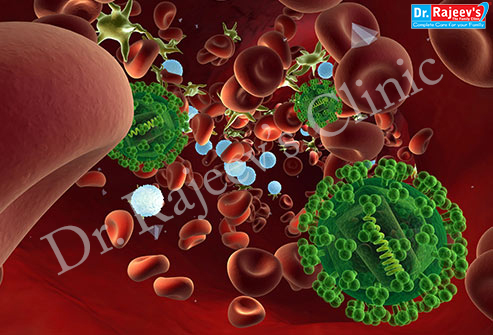

AIDS (Acquired Immune deficiency syndrome) is a disease caused by a virus called HIV. HIV stands for Human Immunodeficiency Virus. HIV infection is a serious condition in the world today. World Health Organization (WHO) has considered AIDS as Pandemic (epidemic across the very large region) disease.
As the name suggests, HIV virus leads to the deficiency of the immunity in humans. That, in turn, leads to a range of disease conditions, primarily due to seriously impaired immunity due to the invasion of the virus. AIDS leads to decrease in the body's self-healing mechanism and many opportunistic infections like Tuberculosis, Pneumonia, fungal infection; diarrhea, etc. affect the body.

From 1981 to 2006 over 25 million people have died due to HIV infection. About 0.26 million children have died of AIDS in 2009. Estimated 0.6% world population suffers from AIDS.
The causative organism of AIDS is HIV virus, which was discovered in 1982 by two scientists Robert Gallo and Luc Montagnier, individually. This virus was found in some gay individuals who suffered from the then-unknown infection. HIV virus is believed to have come from chimpanzees. There are two types of HIV virus, simply called HIV type I and HIV type II. Type I is the most common.
HIV-1 is more dangerous and more infective and is the cause of the majority of HIV infections globally. HIV-2 is known to infect about 5% of all HIV infections., more common in West African countries.
HIV virus infection is always routed through blood, semen, vaginal fluid, pre-ejaculation fluid (pre-cum), or breast milk. The transfer of virus may take place through these fluids. It may transfer via genital, anal, or anal routes through sexual contact. HIV never transmits by air or touch.
Infected syringes by doctors, nurses, drug-addicts, tattooing, etc. form another major source of infection. HIV is largely a sexually transmitted disease. It must be noted that HIV does not spread by a touch of healthy skin to healthy skin.
Once a person is infected with HIV, the virus is present both as free virus and virus within infected body cells. In simple words, HIV virus attacks white blood cells, called CD4 cells. White blood cells are fighter cells. As a result, CD4 cells get destroyed and reduce in number, which leads to collapse of immune or defense mechanism. As the number of CD4 cells keeps reducing, the patient continues getting prone to various infections such as colds, chest infections, Tuberculosis, diarrhea, typhoid, viral fevers, and many other conditions (diseases) like psoriasis, arthritis, weight loss, tumors, and even cancer.
Every person infected with HIV virus is not labeled as a case of AIDS. Time taken for the appearance of AIDS symptoms varies from patient to patient and it depends upon patient’s immunity, number of viral episodes, and environmental factors.
Most of the patients may develop AIDS within 10 years of HIV infection. While few of them may progress much sooner, and some will take much longer. Treatment of HIV infected patients with anti-retroviral may increase the life expectancy.
Following infection with HIV a period of rapid viral multiplication ensues, leading to an abundance of virus in the blood. There can be millions of viruses per milliliter of blood during this primary infection. HIV then brings internal changes in RNA and DNA and gets integrated within. As a result of these changes, the immune system is not able to detect the virus inside the body and simultaneously virus keep on destroying cells responsible for immunity.
 SYMPTOMS OF AIDS/HIV
SYMPTOMS OF AIDS/HIVHIV infection may remain silent and without any symptoms for days or months.
It is observed that few patients may show early symptoms once they get infected with HIV. Following early symptoms may be misdiagnosed as influenza.
These symptoms may occur 4-7 years after infection with HIV. Following signs and symptoms may be warning signs of late-stage HIV infection:
Increased risk of Cancer, lymphoma, Kaposi’s sarcoma, and cervical cancer.
Many patients may develop influenza-like symptoms called as acute HIV infection (usually 2-4 weeks post-exposure). The common symptoms are
These symptoms are often considered as a common viral infection and not HIV infection. The patient is much more infectious during this period and recognizing the syndrome can be important.
Presence of HIV in blood or other body fluid can be done with
There is no vaccine yet available to prevent HIV infection.